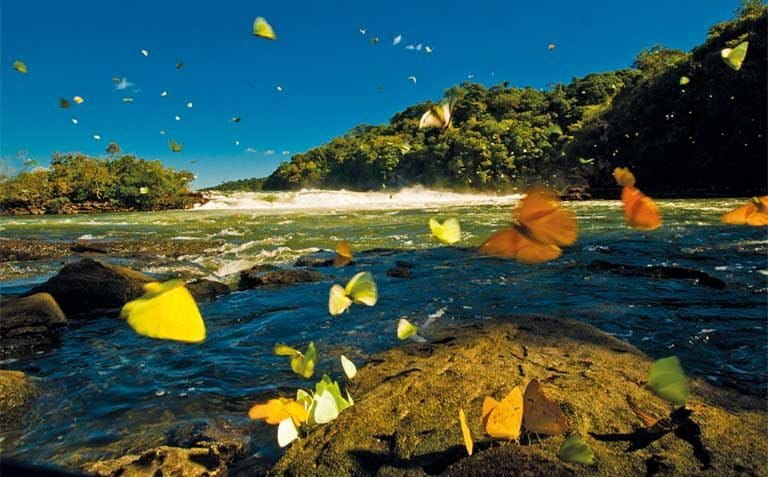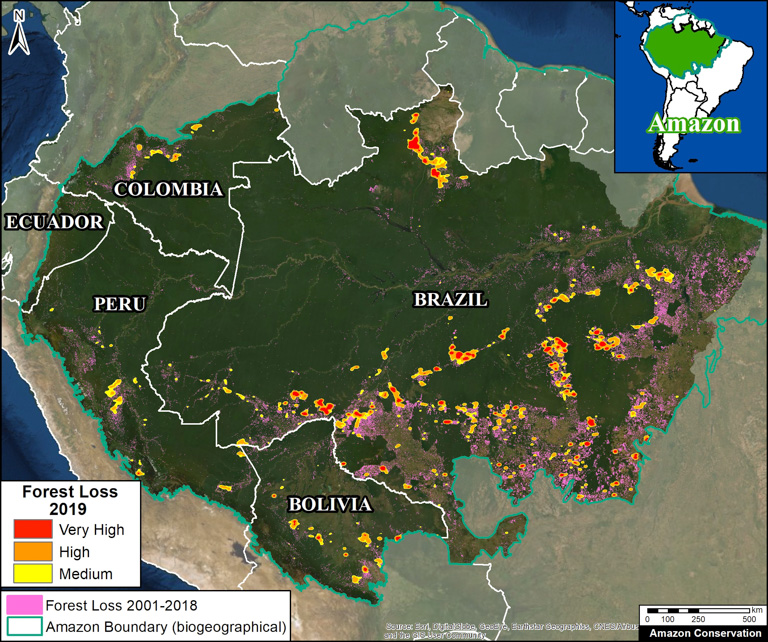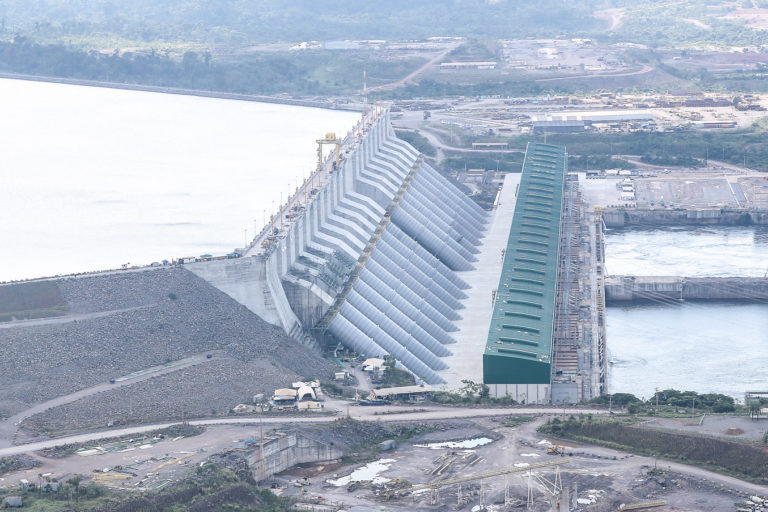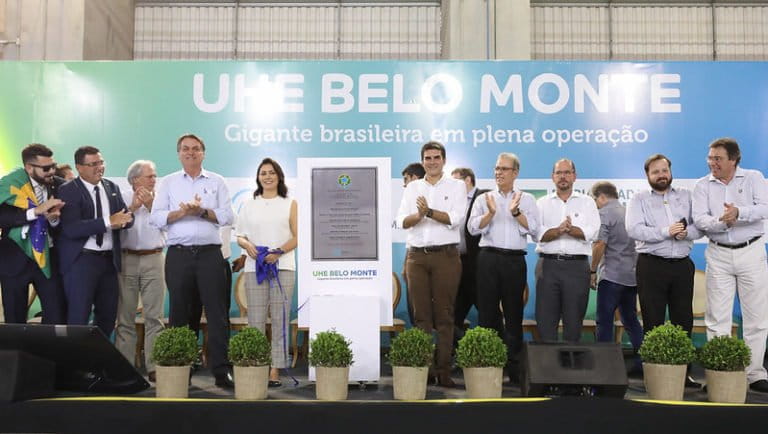- Scientists are sounding the alarm: the Brazilian Amazon is dangerously close to, or may already be hitting, a disastrous rainforest-to-savanna tipping point, with heightened drought driven by regional and global climate change, rapidly rising deforestation and more numerous and intense wild fires.
- Overshooting the tipping point would not only be cataclysmic to Amazon biodiversity and release massive amounts of forest carbon destabilizing the planet’s climate further, it could also devastate Brazil’s economy by depriving agribusiness and hydroelectric energy production of water.
- Signs of deepening drought are already evident, as are serious repercussions. The $9.5 billion Belo Monte mega-dam for example, is already seeing greatly reduced seasonal flows in the Xingu River, a trend expected to worsen, potentially making the dam economically unviable, while also threatening the proposed Belo Sun goldmine.
- Reduced rainfall and a shorter growing season are also putting Brazilian agribusiness at risk. Even as scientists rush to develop heat and drought-resistant crops, many doubt new cultivars will keep pace with a changing climate. The Bolsonaro government is ignoring the economic threat posed by the tipping point

Overshooting an Amazon rainforest-to-savanna tipping point would be “catastrophic” to Brazil’s economic powerhouses, experts have told Mongabay — with especially far-reaching impacts for the nation’s agribusiness and energy sectors, and possibly with repercussions for international food security.
As far back as colonization, water abundance in the Amazon biome was taken for granted, benefitting agriculture, commodities transport on Brazilian waterways, and electric power generation at numerous dams. But now, the hydrological cycle is under increasing threat.
Water has always been the lifeblood of the rainforest — it percolates into soils and aquifers, flows down rivers, also up into trees, and east to west across the sky. The Amazon River, fed by its tributaries, pours an astounding 17 billion metric tons of water into the Atlantic Ocean daily. And on a typical sunny day, trees pump another 20 billion tons into the air — a flow of humidity nicknamed the flying rivers. So it is that the rainforest assures precipitation to large swathes of South America, including Brazil’s thirsty mega-cities.
But, scientists warn, pass beyond a critical threshold — a tipping point forced by regional and global climate change, rampant deforestation and intensifying wildfires — and the forests could begin to self-destruct. Studies have found that up to 70% of the Amazon rainforest could morph into a dry, degraded savanna or scrubland in 50 years.


Tipping point poised to impact ecosystems and economies
The Amazon rainforest and its treasure trove of biodiversity depend on stupendous amounts of rain to thrive, and so too does much of Brazil’s commodity-based economy. A large-scale forest dieback could have major economic repercussions for agribusiness and hydroelectric dams. Mongabay spoke to top scientists who have modelled the consequences of an epic shift in the world’s largest hydrological cycle. It’s not looking good.
First off, some major rivers — including the Xingu, Tapajós and Madeira Rivers of the Amazon Basin — could see drastically reduced flows in the dry season, which would not only impact ambitious hydroelectric projects, but also affect mining operations that rely on the dams for energy, while also making the rivers less navigable for ore and soy transport. Local economies would be harmed too, damaging indigenous and traditional communities that depend on rivers for fishing, travel and drinking water.
In the long run, big business and the nation could suffer severely if urgent action isn’t taken to prevent the tipping point. In 2019, for example, Brazil’s farm exports exceeded US$80 billion, with soy and sugar products among the highest earners. However, deepening drought could cause areas where low-risk soy farming can take place to decrease by 40% in fifty years.
To reverse the current trend, global carbon emissions and Amazon deforestation must be checked and an ambitious reforestation plan adopted now, said leading climate scientist Carlos Nobre.
Instead, the Brazilian government is going in the opposite direction. During Brazilian President Jair Bolsonaro’s first year in power, deforestation rose to an 11-year high as environmental protection programs were stripped of personnel and funding, and that deforestation rate has continued its torrid pace upward into 2020.
Though Bolsonaro’s radical Amazon development policies may win him political points with shortsighted farmers and ranchers looking to collect short term profits, those initiatives could trigger soaring deforestation and hasten the tipping point — which would be devastating to Brazil’s economy.
“Brazil should be battling the most [to protect the Amazon], because it has the most to lose,” Nobre said.

Amazon water cycle is changing
Ten years ago, a Brazilian farmer with 30-years-experience growing crops in the Amazon state of Rondônia approached researcher and climatologist Marcos Costa, with the United Nations Intergovernmental Panel on Climate Change, and asked: “Why is it that every year, the rain starts a little bit later?”
Lacking an answer, Costa decided to find out. His research confirmed the farmer’s observation: On average, the Amazon wet season was starting later every year, a trend driven by regional deforestation and climate change. Today, in deforested areas of the Southern Amazon the seasonal delay of rains averages between 15 and 30 days compared to 1980, a timeframe of just 40 years.
But matters are getting worse. According to Costa, total rainfall is beginning to decrease as well. A NASA study published in November found that the atmosphere over the Amazon has been drying out for the last two decades. “We expect something even more somber in the future,” Costa says. “And this has an impact on agriculture and on the generation of electric energy.”
However, drought isn’t the sole harmful trend. While the Amazon suffered severe drought in 2005, 2010 and 2015, it broke historical records for flooding in 2009, 2012, and 2014 — damaging property, drowning livestock, flooding croplands, increasing pesticide runoff into rivers impacting fisheries, escalating disease breakouts and worsening isolation of riverine communities dependent on boat travel. In fact, these sorts of extreme climate swings — from record dry to record wet — are intensifying.
Despite flood years, the Amazon is becoming consistently dryer; water-loving trees are being replaced by dry-loving vegetation. That means less evaporation, said Yadvinder Malhi, a rainforest expert at Oxford University. And eventually, “Once you start passing this tipping point, you then see a decline in rivers and an intensification of climate events.”

The hydroelectric deficit
Hydropower currently provides two-thirds of Brazil’s electricity. Dams are also a major driver of the nation’s financial wellbeing, with 31.6% of the hydropower generated in 2019 going to the industrial sector — including large mining operations in the Amazon and elsewhere. Another 4.7% is used by agribusiness.
But climate variability is already reducing energy output, says a 2019 report by the International Hydropower Association. How drastic that reduction may ultimately depend on the research you look at. As drought increases and river flows slacken, the nation’s hydropower potential could fall by more than 80% before 2070, according to one study. Electrical generation losses could average 40% for Amazon hydropower dams by the end of the century according to other models.
Research led by top hydrologist Eduardo Martins at the Ceará Foundation for Research and Culture compared results from 25 different models, and while there was some variability, all pointed in the same direction: Amazon hydroelectric dams are set to lose 20% of their river flows by 2070, and up to 60% by 2100 in the more pessimistic climate scenarios.
As the dry season lengthens, the number of rainy months that hydropower producers can operate in are reduced, with far-reaching economic consequences for the country and big business. The Amazon’s Belo Monte mega-dam, for example, which cost $9.5 billion to build and only became fully operational in 2019, is already seeing greatly reduced seasonal flows in the Xingu River due to climate change and upstream deforestation, a trend expected to worsen, potentially making the dam economically unviable — a fate that could doom the planned Belo Sun goldmine which needs huge amounts of electricity to run.

Brazil faces an energy paradox, says Roberto Schaeffer, an expert in energy economics at the Federal University of Rio de Janeiro: “Countries that are [already] very dependent on renewables [such as hydropower] may have to depend more on fossil fuels in the future to deal with the effects of climate change.”
A possible proof of that assertion: In November Belo Monte dam operator Norte Energia asked Brazil’s National Electric Energy Agency for authorization to build thermoelectric plants alongside its mega-dam — power plants that will likely burn fossil fuels.
According to Schaeffer’s estimates, the Brazilian energy sector will need to invest an additional US$50 billion between now and 2035 to compensate for lost hydropower capacity due to climate change, requiring the purchase of electricity from other sources, possibly including greenhouse gas-producing coal. “They will try to compensate for that lost energy at a minimum cost,” he explains.
Solar and wind power are potential alternatives, but they too require new investments, and present challenges of their own. Solar power, for example, is only available 10 to 12 hours a day, and must be stored in costly batteries: “Some of these batteries need heavy metals, so we’d have an increased demand for mining, with all its negative impacts,” Costa added. “The world has an abundance of materials for cell phones and laptops batteries [right now]. But if [those minerals] start being needed to store all our energy, this could be a big problem looking forward.” Another knock on effect: if drought forces more farmers to irrigate crops, that could lower river levels further, and worsen the hydropower crisis.
“Undergoing these hydrological changes, will Brazil go back to [choosing] dirty energy over clean energy?” asks economist Monica deBolle at the Peterson Institute for International Economics. To bridge the hydroelectric gap, non-renewable energy sources such as natural gas or even coal could make a comeback, according to Brazil’s official 10-year energy plan.
Even as the Amazon biome reaches a tipping point, and river flows decrease, with dams making fewer megawatts, there will still be a greater demand for power. In Brazil, climate change will cause temperatures to rise inexorably, especially on urban heat islands, creating a clamor for more air conditioning, more refrigeration and more electricity.

Brazil: an agribusiness economy dependent on nature
The Amazon tipping point will make farming more difficult, expensive and a bigger investment gamble, say scientists. Rural areas considered low risk today, for example, will become high or medium-risk ventures over coming decades, according to research by the Brazilian Panel on Climate Change.
Carlos Nobre explained why: Brazil is “already at the limit of [agricultural] productivity. If we lose control of global warming, we are talking about the Cerrado [savanna biome] becoming impossible for agriculture,” he said. The Cerrado today is Brazil’s most rapidly expanding agricultural frontier — a juggernaut of soy, cotton, corn and cattle production, with exports vital to the Brazilian economy.
But that economic juggernaut — which provides vast amounts of soy to feed livestock in the European Union, China and United Kingdom — is dependent on plentiful rainfall.
Nobre points out that the tipping point isn’t merely a future abstraction: its impacts are already being felt in Mato Grosso — a state that includes parts of the Amazon and Cerrado biomes, a prodigious producer of Brazilian soy, and an area already enduring alarming changes in the hydrological cycle.
Big agribusiness companies are noticing those changes: Amaggi — a Brazilian commodities firm and the world’s largest private soy producer — has already observed “more concentration of rain over a lesser amount of days.” And the company is looking to technology to mitigate impacts: “The market has sought cultivars that are resistant to longer periods of drought,” Amaggi told Mongabay. “These are technological resources that permit adaptation to these rainfall changes that can occur between one crop and another, maintaining production levels.”
But adaptation will work only to a point. Scientists warn that escalating drought will intensify farmers’ economic risk. “So far, there’s already been a 100 millimeter decrease in rain supply [annually]. If you’re talking about 1,500 mm a year, losing 100 isn’t huge, but it is going to get worse,” said researcher Eduardo Assad, with the Brazilian Agricultural Research Corporation (Embrapa). If annual rainfall declines to 1,000 mm, then production is still possible, but crops becomes very vulnerable.”

Assad’s research at Embrapa has led to new soy varieties adapted to water deficiency and more heat, but genetic improvement is a long and expensive path and isn’t enough on its own. “We can develop soy that tolerates an extra two degrees, but what if the temperature rises by three?” he asks. New climate sensitivity models still being tested but due out next year are showing a potential temperature rise by 2100 of up to 5.6 degrees Celsius (10 degrees Fahrenheit). No one has developed a soybean to survive that kind of heat.
Deforestation adds to the problem: “The effect of a savannization of the Amazon would be catastrophic. It makes no sense to talk about [increased] agricultural production with the rate of deforestation as it is today,” Assad concluded. Deforestation rapidly dries out the landscape, intensifying drought and diminishing harvests.
Economist Juliano Assunção, executive director for the Climate Policy Initiative Brazil, agrees: “Deforestation is a huge waste of resources. Economic interest [by agribusiness] in [deforested] areas is very limited,” he said, proving his point by noting that a fourth of newly clear-cut land in Brazil is later abandoned. “Deforestation is an illegal activity with very little economic importance and low productivity,” said Assunção, though it is an activity that does greatly benefit land speculators and land grabbers.
Declining Brazilian agricultural capacity isn’t only a national concern. Global population is expected to shoot above 8 billion by 2023, and with it, the demand for more food. One study predicts food demand may increase by as much as 98% by 2050 — a need that a far dryer Brazil could find very difficult to satisfy.

Shrinking water supply meets rising demand
Farmers that look to adapt to reduced rainfall by turning to irrigation won’t find that shift easy. Today, less than 10% of Brazilian crops are irrigated, but with less rain and increased demand, rising tensions and water wars are likely. “You’ll be competing for a scarce resource,” said Schaeffer.
Northern Brazil, where the Amazon is located, already saw an increase in irrigation of over 240% from 2006 to 2017. And obviously, the more water that leaves rivers and goes to the big plantations, the less that will be left for hydroelectric generation, transportation, and the rainforest’s traditional communities.
As rivers become depleted, experts say that it will be the smallholders who are likely to lose in a tug of war over Amazon water. “It’s become difficult to grow crops that demand the full six-month growing period. So farmers often have to opt for crops with a shorter cycle. Life has become far more precarious,” said Antônio José Bentes, a coordinator at SAPOPEMA (the Society for Research and Protection of the Environment), a small NGO based in the Amazon.
Bentes has seen farmers switching to crops that don’t depend on a full 6-month cycle to adapt to the intermittent rain, like jerimum, a kind of pumpkin. As it can be cultivated in a few months, production has almost doubled in the last year. “Production of jerimum in the region of Santarém increased from 100 tons in 2018 to 180 tons in 2019,” he said.
“With changes in rain cycles, you alter the patterns of harvest and planting. Large farmers can accommodate, but it’s not as easy for small farmers that use their land to survive,” explained deBolle. Changes in climate will hit poor families the hardest and may even cause a migration crisis similar to what is happening in Central America.

A dying Amazon: political and social risks
In his first year in office, Bolsonaro was in denial of climate change; his foreign minister believes global warming is a Chinese plot for world domination. The administration has also turned a blind eye to the science and looming risk posed by the Amazon Tipping Point.
The President has so far shown disdain for Brazil’s past environmental policy — a model to the world that drastically reduced deforestation — and he is a cheerleader for aggressive Amazon development, with plans to expand mining, oil exploration and agribusiness into indigenous reserves, and to build new roads and dams — all initiatives that could force the rapid advancement of the tipping point.
Some pragmatic agricultural producers see a stable regional climate as a priority, but others write off the science as a myth, Assunção said. “Every day I ask myself why [parts of the agribusiness lobby] are fighting against the environmental agenda with such force, because it’s so relevant for agriculture,” he told Mongabay. “It’s difficult to understand the rationale behind this. It’s not associated [with] relevant economic activities so why are they disorganizing a working policy at such a huge reputational cost?”
And that cost could be very high: Bolsonaro’s largely nonnegotiable anti-environmental agenda could get in the way of closing the deal on the world’s largest trade agreement between Mercosur — a group of Latin American trading partners including Brazil — and the European Union. Opposition to the trade pact is growing in the EU, based on last year’s Amazon fires and the Brazilian president’s policies.
Avoiding climate risks, Costa says, is “in the best interests of agribusiness.” Shifts in seasonal and overall rainfall patterns can impact productivity, profits and even food security, he wrote in a 2019 article.
Risky environmental storylines — like the Amazon Tipping Point or Bolsonaro’s Amazon development plans — can also scare off investors in agribusiness and increase the threat of international consumer boycotts, said deBolle. “Brazil’s geopolitical strength is the environment,” she said. “Until not very long ago, we were in a privileged position.”
Brazil’s current image problem isn’t just environmental, it’s also social and economic, deBolle added, pointing out that a sizeable portion of the Amazon population lives off extraction. “With the forest dying, their sustenance is killed. What happens with these people in a situation where the forest starts to disappear?”

It’s expected that Bolsonaro’s extreme positions will spark even harsher pushback nationally and internationally over the next three years of his term, as he pushes to exploit the rainforest, doing so at great risk to Brazil and the planet.
According to a recent Climate Observatory report, none of Brazil’s 2015 Paris Climate agreement targets are currently being met, and its 2020 deforestation goals have already been missed. “What happens in Brazil, doesn’t stay in Brazil,” the NGO report warns. An Amazon dieback could have worldwide impacts, with Brazil singlehandedly endangering the key Paris goal of stabilizing global warming at 1.5 degrees Celsius (2.7 degrees Fahrenheit) above preindustrial levels.
But it’s not only up to Brazilians, Schaeffer said. “It’s not just about what can be done here. Even if Brazil violently reduces its emissions [by curbing deforestation], and China and Europe don’t [cut theirs], it doesn’t solve the issue.” Global climate change will continue pushing the Amazon beyond the tipping point, only more slowly.
“What the world can do [to save the Amazon] is fulfill the promises made by those respectable people in suits and ties at the Paris Agreement,” he concluded.
Banner Image caption: The Amazon ablaze August 2019. Image by Victor Moriyama / Greenpeace.
Correction: As originally published, this story reported that Roberto Schaeffer is at the University of São Paulo. The text has been corrected to show that he is at the Federal University of Rio de Janeiro.
FEEDBACK: Use this form to send a message to the author of this post. If you want to post a public comment, you can do that at the bottom of the page.
